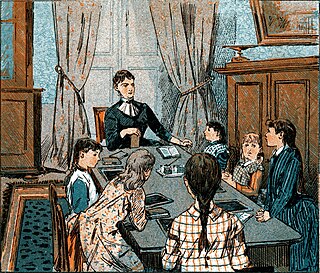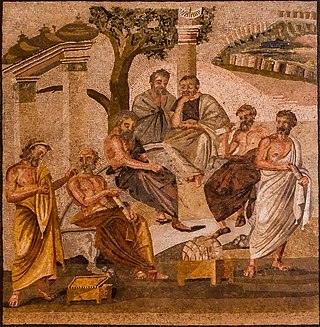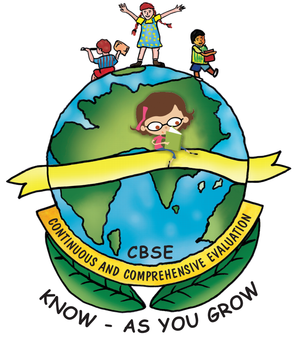Purposes
The primary purpose of traditional education is to continue passing on those skills, facts, and standards of moral and social conduct that adults consider to be necessary for the next generation's material advancement. As beneficiaries of this plan, which educational progressivist John Dewey described as being "imposed from above and from outside", the students are expected to docilely and obediently receive and believe these fixed answers. Teachers are the instruments by which this knowledge is communicated and these standards of behavior are enforced.
Historically, the primary educational technique of traditional education was simple oral recitation: In a typical approach, students spent some of their time sitting quietly at their places and listening to one student after another recite his or her lesson, until each had been called upon. The teacher's primary activity during such sessions was assigning and listening to these recitations; students studied and memorized the assignments at home. A test or oral examination might be given at the end of a unit, and the process, which was called "assignment–study–recitation–test", was repeated. There was also a reliance on rote memorization (memorization with no effort at understanding the meaning). It is believed that the use of recitation, rote memorization, and unrelated assignments is inefficient and an extremely inefficient use of students' and teachers' time. This traditional approach also insisted that all students be taught the same materials at the same point; students that did not learn quickly enough failed, rather than being allowed to succeed at their natural speeds. This approach, which had been imported from Europe, dominated American education until the end of the 19th century, when the education reform movement imported progressive education techniques from Europe.
Traditional education is associated with much the modern era. Some schools incorporated emphasis on skills to be used for real estate, family planning, cooking, and tool usage. In the USA, collective discipline is not used as much as it used to be, towards a slow shift of individualism, such that the use of corporal punishment to maintain classroom discipline or punish errors is not encouraged and made illegal at the federal level. Other elements of schooling which were more prevalent before the federal government asserted legislative dominion over that of state institutions, include specific religion's and languages, separating students according to sex, race, and social class, albeit this still occurs in a de jure manner throughout the USA. Currently, many private schools continue to show impressive diversity and outcomes, for example using elements of asynchronous learning, subject differentiation between boys and girls. Outcomes in urban areas vs suburban areas are an area of vigorous contention given relative differences in school diversity.
The following outline is provided as an overview of and topical guide to education:
Progressive education, or educational progressivism, is a pedagogical movement that began in the late 19th century and has persisted in various forms to the present. In Europe, progressive education took the form of the New Education Movement. The term progressive was engaged to distinguish this education from the traditional curricula of the 19th century, which was rooted in classical preparation for the early-industrial university and strongly differentiated by social class. By contrast, progressive education finds its roots in modern, post-industrial experience. Most progressive education programs have these qualities in common:

Homeschooling or home schooling, also known as home education or elective home education (EHE), is the education of school-aged children at home or a variety of places other than a school. Usually conducted by a parent, tutor, or online teacher, many homeschool families use less formal, more personalized and individualized methods of learning that are not always found in schools. The actual practice of homeschooling varies considerably. The spectrum ranges from highly structured forms based on traditional school lessons to more open, free forms such as unschooling, which is a lesson- and curriculum-free implementation of homeschooling. Some families who initially attended a school go through a deschool phase to break away from school habits and prepare for homeschooling. While "homeschooling" is the term commonly used in North America, "home education" is primarily used in Europe and many Commonwealth countries. Homeschooling should not be confused with distance education, which generally refers to the arrangement where the student is educated by and conforms to the requirements of an online school, rather than being educated independently and unrestrictedly by their parents or by themselves.
Humanistic education is an approach to education based on the work of humanistic psychologists, most notably Abraham Maslow and Carl Rogers. Rogers is regarded as the founder of humanistic psychology and devoted much of his efforts toward applying the results of his psychological research to person-centered teaching where empathy, caring about students, and genuineness on the part of the learning facilitator were found to be the key traits of the most effective teachers. He edited a series of books dealing with humanistic education in his "Studies of the Person Series," which included his book, Freedom to Learn and Learning to Feel - Feeling to Learn - Humanistic Education for the Whole Man, by Harold C. Lyon, Jr. In the 1970s the term "humanistic education" became less popular after conservative groups equated it with "Secular Humanism" and attacked the writings of Harold Lyon as being anti-Christian. That began a successful effort by Aspy, Lyon, Rogers, and others to re-label it "person-centered teaching", replacing the term "humanistic education." In a more general sense the term includes the work of other humanistic pedagogues, such as Rudolf Steiner, and Maria Montessori. All of these approaches seek to engage the "whole person": the intellect, feeling life, social capacities, and artistic and practical skills are all important focuses for growth and development. Important objectives include developing children's self-esteem, their ability to set and achieve appropriate goals, and their development toward full autonomy.
An alternative school is an educational establishment with a curriculum and methods that are nontraditional. Such schools offer a wide range of philosophies and teaching methods; some have political, scholarly, or philosophical orientations and foundings, while others are in response to a need for local or regional desire of diverse educational and vocational outcomes not necessarily fostered through mainstream or federally-regulated public schooling.

Pedagogy, most commonly understood as the approach to teaching, is the theory and practice of learning, and how this process influences, and is influenced by, the social, political, and psychological development of learners. Pedagogy, taken as an academic discipline, is the study of how knowledge and skills are imparted in an educational context, and it considers the interactions that take place during learning. Both the theory and practice of pedagogy vary greatly as they reflect different social, political, and cultural contexts.

In education, a curriculum is the totality of student experiences that occur in an educational process. The term often refers specifically to a planned sequence of instruction, or to a view of the student's experiences in terms of the educator's or school's instructional goals. A curriculum may incorporate the planned interaction of pupils with instructional content, materials, resources, and processes for evaluating the attainment of educational objectives. Curricula are split into several categories: the explicit, the implicit, the excluded, and the extracurricular.
Founded in 1920, The National Council of Teachers of Mathematics (NCTM) is a professional organization for schoolteachers of mathematics in the United States. One of its goals is to improve the standards of mathematics in education. NCTM holds annual national and regional conferences for teachers and publishes five journals.
The educational system of Myanmar is operated by the government Ministry of Education. Universities and professional institutes from upper Burma and lower Burma are run by two separate entities, the Departments of Higher Education, whose office headquarters are in Yangon and Mandalay respectively. The modern education system is based on the system implemented during British rule in Burma. "The first Government high school was founded by the British colonial administration in 1874. Two years later, this Government High School was upgraded and became University College, Rangoon." Nearly all schools are government-operated, but recently, there has been an increase in privately funded schools. In Myanmar, schooling is compulsory until the end of elementary school, probably about nine years old. However the international standard for schooling is 15 to 16 years old.

The history of education extends at least as far back as the first written records recovered from ancient civilizations. Historical studies have included virtually every nation. The earliest known formal school was developed in Egypt's Middle Kingdom under the direction of Kheti, treasurer to Mentuhotep II. In ancient India, education was mainly imparted through the Vedic and Buddhist education system, while the first education system in ancient China was created in Xia dynasty. In the city-states of ancient Greece, most education was private, except in Sparta. For example, in Athens, during the 5th and 4th century BC, aside from two years military training, the state played little part in schooling. The first schools in Ancient Rome arose by the middle of the 4th century BC.

The history of education in Japan dates back at least to the sixth century, when Chinese learning was introduced at the Yamato court. Foreign civilizations have often provided new ideas for the development of Japan's own culture.
Curriculum theory (CT) is an academic discipline devoted to examining and shaping educational curricula. There are many interpretations of CT, being as narrow as the dynamics of the learning process of one child in a classroom to the lifelong learning path an individual takes. CT can be approached from the educational, philosophical, psychological and sociological perspectives. James MacDonald states "one central concern of theorists is identifying the fundamental unit of curriculum with which to build conceptual systems. Whether this be rational decisions, action processes, language patterns, or any other potential unit has not been agreed upon by the theorists." Curriculum theory is fundamentally concerned with values, the historical analysis of curriculum, ways of viewing current educational curriculum and policy decisions, and theorizing about the curricula of the future.
Anti-oppressive education encompasses multiple approaches to learning that actively challenge forms of oppression.
Inquiry-based learning is a form of active learning that starts by posing questions, problems or scenarios. It contrasts with traditional education, which generally relies on the teacher presenting facts and their knowledge about the subject. Inquiry-based learning is often assisted by a facilitator rather than a lecturer. Inquirers will identify and research issues and questions to develop knowledge or solutions. Inquiry-based learning includes problem-based learning, and is generally used in small-scale investigations and projects, as well as research. The inquiry-based instruction is principally very closely related to the development and practice of thinking and problem-solving skills.

A vocal school, blab school, ABC school or old-time school was a type of children's primary school in some remote, rural places in North America in the 19th century, which became increasingly outdated and obsolete as the century progressed. The school children recited (blabbed) their lessons out loud separately or in chorus with others as a method of learning.

Continuous and Comprehensive Evaluation (CCE) was a process of assessment, mandated by the Right to Education Act, of India in 2009. This approach to assessment was introduced by state governments in India, as well as by the Central Board of Secondary Education in India, for students of sixth to tenth grades and twelfth in some schools. It was intended to provide students with practice from a young age for the board exams. In 2017, the CCE system was cancelled for students appearing in the Class 10 Board Exam for 2017–18, bringing back compulsory Annual Board Exam and removing the Formative and Summative Assessments under the Remodeled Assessment Pattern.
Feminist pedagogy is a pedagogical framework grounded in feminist theory. It embraces a set of epistemological theories, teaching strategies, approaches to content, classroom practices, and teacher-student relationships. Feminist pedagogy, along with other kinds of progressive and critical pedagogy, considers knowledge to be socially constructed.
In education, authentic learning is an instructional approach that allows students to explore, discuss, and meaningfully construct concepts and relationships in contexts that involve real-world problems and projects that are relevant to the learner. It refers to a "wide variety of educational and instructional techniques focused on connecting what students are taught in school to real-world issues, problems, and applications. The basic idea is that students are more likely to be interested in what they are learning, more motivated to learn new concepts and skills, and better prepared to succeed in college, careers, and adulthood if what they are learning mirrors real-life contexts, equips them with practical and useful skills, and addresses topics that are relevant and applicable to their lives outside of school."
Madrasahs in Singapore are full-time, religious institutions that offer a pedagogical mix of Islamic religious education and secular education in their curricula. While the Arabic term 'madrasah' literally translates to 'school', whether religious or secular, the term 'madrasah' is legally and colloquially defined in Singapore today as an 'Islamic religious school'. There are currently six madrasahs in Singapore offering primary to tertiary education, namely, Aljunied Al-Islamiah, Irsyad Zuhri Al-Islamiah, Al-Maarif Al-Islamiah, Alsagoff Al-Arabiah, Al-Arabiah Al-Islamiah, and Wak Tanjong Al-Islamiah. Four of them are co-educational, while the other two offer madrasah education exclusively to girls.

The term learning environment can refer to an educational approach, cultural context, or physical setting in which teaching and learning occur. The term is commonly used as a more definitive alternative to "classroom", but it typically refers to the context of educational philosophy or knowledge experienced by the student and may also encompass a variety of learning cultures—its presiding ethos and characteristics, how individuals interact, governing structures, and philosophy. In a societal sense, learning environment may refer to the culture of the population it serves and of their location. Learning environments are highly diverse in use, learning styles, organization, and educational institution. The culture and context of a place or organization includes such factors as a way of thinking, behaving, or working, also known as organizational culture. For a learning environment such as an educational institution, it also includes such factors as operational characteristics of the instructors, instructional group, or institution; the philosophy or knowledge experienced by the student and may also encompass a variety of learning cultures—its presiding ethos and characteristics, how individuals interact, governing structures, and philosophy in learning styles and pedagogies used; and the societal culture of where the learning is occurring. Although physical environments do not determine educational activities, there is evidence of a relationship between school settings and the activities that take place there.







